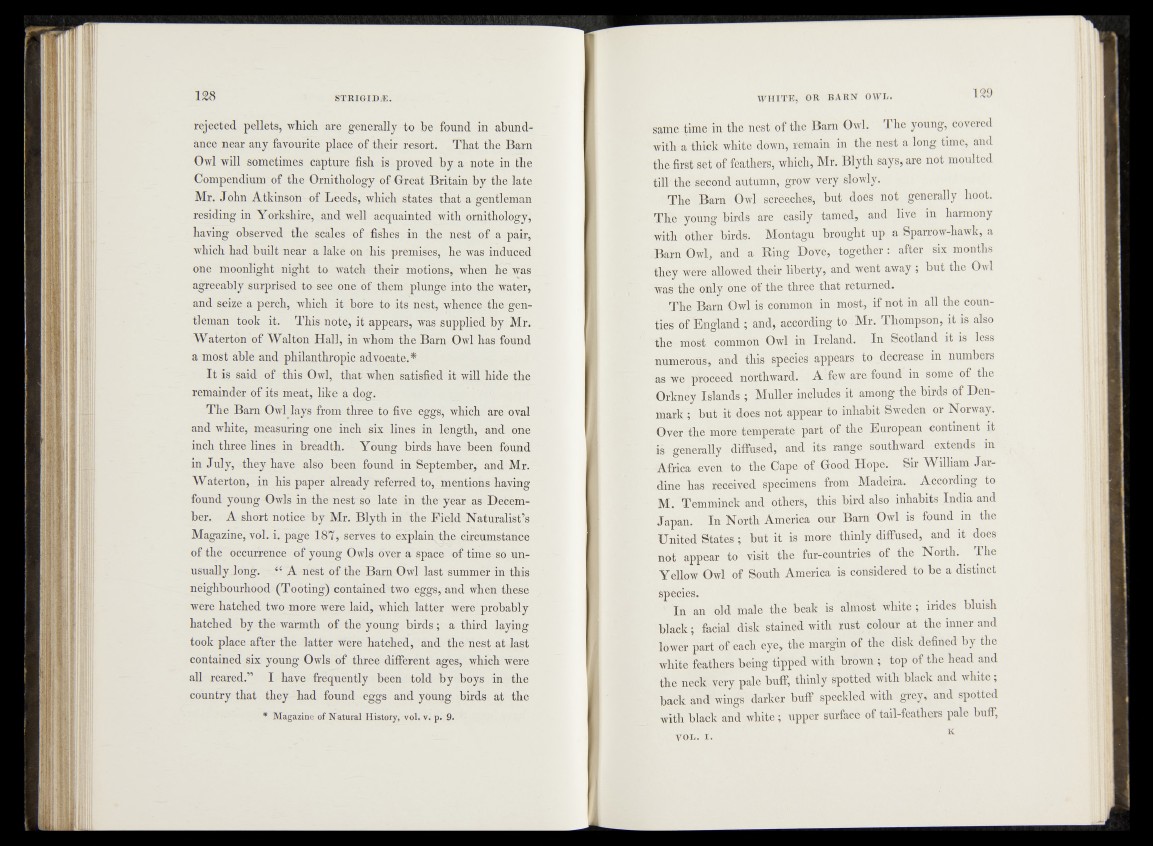
rejected pellets, which are generally to be found in abundance
near any favourite place of their resort. That the Barn
Owl will sometimes capture fish is proved by a note in the
Compendium of the Ornithology of Great Britain by the late
Mr. John Atkinson of Leeds, which states that a gentleman
residing in Yorkshire, and well acquainted with ornithology,
having observed the scales of fishes in the nest of a pair,
which had built near a lake on his premises, he was induced
one moonlight night to watch their motions, when he was
agreeably surprised to see one of them plunge into the water,
and seize a perch, which it bore to its nest, whence the gentleman
took it. This note, it appears, was supplied by Mr.
Waterton of Walton Hall, in whom the Barn Owl has found
a most able and philanthropic advocate.*
It is said of this Owl, that when satisfied it will hide the
remainder of its meat, like a dog.
The Barn Owl lays from three to five eggs, which are oval
and white, measuring one inch six lines in length, and one
inch three lines in breadth. Young birds have been found
in July, they have also been found in September, and Mr.
Waterton, in his paper already referred to, mentions having
found young Owls in the nest so late in the year as December.
A short notice by Mr. Blyth in the Field Naturalist’s
Magazine, vol. i. page 187, serves to explain the circumstance
of the occurrence of young Owls over a space of time so unusually
long. “ A nest of the Barn Owl last summer in this
neighbourhood (Tooting) contained two eggs, and when these
were hatched two more were laid, which latter were probably
hatched by the warmth of the young birds; a third laying
took place after the latter were hatched, and the nest at last
contained six young Owls of three different ages, which were
all reared.” I have frequently been told by boys in the
country that they had found eggs and young birds at the
* Magazine of Natural History, vol. v. p. 9.
same time in the nest of the Barn Owl. The young, covered
with a thick white down, remain in the nest a long time, and
the first set of feathers, which, Mr. Blyth says, are not moulted
till the second autumn, grow very slowly.
The Barn Owl screeches, but does not generally hoot.
The young birds are easily tamed, and live in harmony
with other birds. Montagu brought up a Sparrow-hawk, a
Barn Owl, and a Ring Dove, together : after six months
they were allowed their liberty, and went away ; but the Owl
was the only one of the three that returned.
The Barn Owl is common in most, if not in all the counties
of England ; and, according to Mr. Thompson, it is also
the most common Owl in Ireland. In Scotland it is less
numerous, and this species appears to decrease in numbers
as we proceed northward. A few are found in some of the
Orkney Islands ; Muller includes it among the birds of Denmark
; but it does not appear to inhabit Sweden or Norway.
Over the more temperate part of the European continent it
is generally diffused, and its range southward extends in
Africa even to the Cape of Good Hope. Sir William Jar-
dine has received specimens from Madeira. According to
M. Temminck and others, this bird also inhabits India and
Japan. In North America our Barn Owl is found in the
United States ; but it is more thinly diffused, and it does
not appear to visit the fur-countries of the North. The
Yellow Owl of South America is considered to be a distinct
species.
In an old male the beak is almost white ; irides bluish
black; facial disk stained with rust colour at the inner and
lower part of each eye, the margin of the disk defined by the
white feathers being tipped with brown ; top of the head and
the neck very pale buff, thinly spotted with black and white,
back and wings darker buff speckled with grey, and spotted
with black and white; upper surface of tail-feathers pale buff,
VOL. I. K